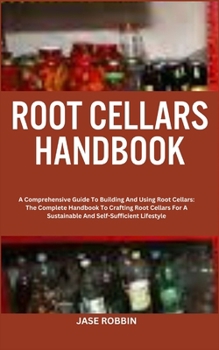Root Cellars Handbook: A Comprehensive Guide To Building And Using Root Cellars: The Complete Handbook To Crafting Root Cellars For A Sustain
The purpose of root cellars is to maintain the freshness of perishable foods such as fruits, vegetables, and other items that require refrigeration by creating an environment that is cold, dark, and humid. These conventional storage areas were especially prevalent prior to the pervasive availability of refrigeration and have been utilized for centuries.
Prominent characteristics of root cellars comprise:
1. Low Temperature: In order to capitalize on the lower temperatures inherent beneath the surface of the earth, root cellars are conventionally positioned underground. A root cellar maintains a relatively constant and lower temperature than the surrounding environment, which aids in decelerating the ripening and decay processes of food that is stored within.
2. Elevated Humidity: Root cellars frequently sustain an elevated relative humidity in comparison to the ambient pressure. This is crucial in order to preserve the moisture and prevent the fruit and vegetable from drying out.
3. Dimness: Root cellars are typically devoid of light or have restricted access to it. The photosynthesis process in plants is slowed by darkness; this is an advantageous property as it prevents the perishability of stored produce.
4. Ventilation: To prevent the accumulation of gases produced by ripening fruits and vegetables, adequate ventilation is vital. Ensuring adequate ventilation is crucial for preserving a sanitary storage environment and inhibiting the buildup of ethylene gas, which has the potential to hasten the maturation process of certain fruits.
5. Insulation: For the root cellar's interior temperature to be regulated, adequate insulation is vital. Frequently, insulating materials such as straw, soil, or other organic substances are employed to aid in the preservation of a consistent and temperate atmosphere.
When food storage for an extended period of time was necessary but modern refrigeration was not readily available, root cellars were commonly employed.
Although root cellars have become less prevalent in recent times due to the widespread availability of refrigerators and freezers, some individuals continue to utilize them as an additional or alternative method for storing and preserving locally sourced or indigenous pr
Prominent characteristics of root cellars comprise:
1. Low Temperature: In order to capitalize on the lower temperatures inherent beneath the surface of the earth, root cellars are conventionally positioned underground. A root cellar maintains a relatively constant and lower temperature than the surrounding environment, which aids in decelerating the ripening and decay processes of food that is stored within.
2. Elevated Humidity: Root cellars frequently sustain an elevated relative humidity in comparison to the ambient pressure. This is crucial in order to preserve the moisture and prevent the fruit and vegetable from drying out.
3. Dimness: Root cellars are typically devoid of light or have restricted access to it. The photosynthesis process in plants is slowed by darkness; this is an advantageous property as it prevents the perishability of stored produce.
4. Ventilation: To prevent the accumulation of gases produced by ripening fruits and vegetables, adequate ventilation is vital. Ensuring adequate ventilation is crucial for preserving a sanitary storage environment and inhibiting the buildup of ethylene gas, which has the potential to hasten the maturation process of certain fruits.
5. Insulation: For the root cellar's interior temperature to be regulated, adequate insulation is vital. Frequently, insulating materials such as straw, soil, or other organic substances are employed to aid in the preservation of a consistent and temperate atmosphere.
When food storage for an extended period of time was necessary but modern refrigeration was not readily available, root cellars were commonly employed.
Although root cellars have become less prevalent in recent times due to the widespread availability of refrigerators and freezers, some individuals continue to utilize them as an additional or alternative method for storing and preserving locally sourced or indigenous pr
Format:Paperback
Language:English
ISBN:B0CR9T298R
ISBN13:9798873512621
Release Date:December 2023
Publisher:Independently Published
Length:168 Pages
Weight:0.38 lbs.
Dimensions:0.4" x 5.0" x 8.0"
Customer Reviews
0 rating





